
Image Credit: Contributed
May 14, 2022 - 7:00 AM
— With reporting by Levi Landry and iNFOnews.ca staff
Before Ben Bowden actually met Katherine McParland, he only knew her by reputation.
People in his circles talked about this young woman in Kamloops, a unicorn who pulled herself out of the life; a kid who grew up in foster care, was homeless, had a drug problem but got clean, went to school, got her degree then started and ran a successful non-profit for kids like she was.
They also talked about Katherine’s ex-boyfriend, who went to prison before she turned her life around.
When he met her in November 2020 at his home in Victoria, it was because her ex-boyfriend wasn’t in prison any longer.
A friend was desperate to get her out of Kamloops and referred her to a therapist specializing in trauma therapy in Victoria and asked Bowden to look out for her.
"I got the call saying... her boyfriend has gotten out of jail and he wants to claim ownership of her. She is allowing this because of guilt from the past and it's not working out well for her,” Bowden said. "There have already been a couple of incidents. He has physically assaulted her. She's not willing to press charges and we need to get her out of town. Can you help out?”
That might sound like a strange phone call, but not for Bowden. He’s not a social worker, but he said he's gotten dozens of calls like this from around the province to help women escape violence — gang violence specifically. He calls himself a fixer of sorts for impossible situations.
"When I cleaned up going through university, I realized there was a need and it wasn't really being addressed. Who takes in the women who are trying to escape organized crime or gangs, such as myself? A woman who is in that kind of situation can't go to a government funded safe house. The (men) already know where the (houses) are. If a woman decides she is going to leave, for the most part, she is trapped."
Thirty years ago, Bowden was the unicorn. He had his own drug habit, was selling drugs and ran up against the Hells Angels, he said. He got out and into recovery, straightened out and went to Thompson Rivers University before trouble caught up to him again and he wound up in prison. He got counselling there and made unofficial contacts who saw the same cracks in the system.
“I have been doing this unofficially for 20 years,” he said. "Part of my way of giving back. My mom was an alcoholic before I was in foster care. She was with a violent alcoholic and we ended up in transition homes. We ended up in women's shelters. He always found us, he always dragged us back.”
This time, it was Katherine at his door and she had already been dragged back.
That was one month before she died.
***

Katherine McParland in Victoria in November 2020.
Image Credit: Ben Bowden
McParland guarded parts of her life closely but it's the story she told of her life that thrust her into a spotlight, made her a media darling, gained her an audience of politicians, funders, bureaucrats and anyone else sympathetic to the plight of homeless kids.
This is how she told that story in a Tedx Talk at Thompson Rivers University in 2018, one she has repeated nearly word-for-word several times before.
"My life trajectory in homelessness began as a young girl at age 5,” she said. "My family moved into the shelter system as we were fleeing an abusive relationship. Shortly after moving into the shelter system, I was brought into foster care. Foster care is where the Ministry for Children and Family Development becomes your mother and father. At age 13 it was determined that I would never return home and I would reside in foster care in Kamloops."
She said she went through 28 foster homes until she was 19 and aged out of foster care, which began her crusade with A Way Home Kamloops. It started with a job she got as a “peer researcher” which involved finding what she called her “foster siblings” — 30 people who had also aged out. She found 23 of them were homeless.
In 2008, she was renting a home in Kamloops but was evicted that November.
"I met an abusive man who ended up kicking in my door which led to an eviction on the first day of snowfall and I joined my foster siblings on the streets of Kamloops,” she said on the Tedx Talk.
Tina Lange was a sitting City of Kamloops councillor when McParland was 19 or 20 and Lange became her landlord.
“She had a place of her own, and of course what happened is all the predators moved in,” Lange told The Tyee. "When I met her, she was the Katherine... you and I know that was beautiful, smiling and happy, bouncing around in a lovely dress. Just the picture of health. And within a month her whole life had changed.”
Some time in 2009, she reconnected with a man she first met through a friend when she was 14 — Sean Fouts.
According to Bowden and confirmed by other sources, he rescued her from that predator.
“He had been there for her when nobody else was,” Bowden said. "He helped her out of a situation that was really bad and like, somebody was trying to turn her into an escort or whatever — a hooker — and Sean had come into play at that time. And basically put her up…. He took care of her financially while she was trying to get her shit together.”
He was 17 years older and by that time already had a lengthy criminal record and spent plenty of time in prison. His record included several property offences, uttering threats, driving offences, trafficking narcotics, robbery — and one case of uttering threats against a spouse.
Several sources also say he was a member of the Independent Soldiers gang.
Katherine developed a drug habit and according to Bowden, Fouts and McParland sold drugs together for a brief time.
"He loved her and he protected her and he did everything for her. He never asked anything of her, he just took care of her.”
It eventually became a romantic relationship but Fouts was arrested roughly a year later in November 2009 on charges of drug trafficking and possession of a prohibited firearm and sentenced a year after that to five years in prison.
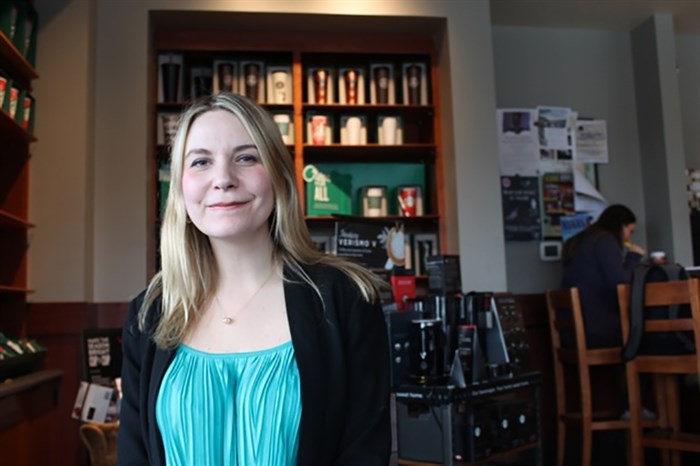
Katherine McParland’s experience as a child in government care and on the street drove her to build a better way for others.
Image Credit: Katie Hyslop/The Tyee
McParland entered rehab and recovery in 2012 and started her ascension. She got a bursary and other supports to attend Thompson Rivers University, got her human services diploma and later she got her master of social work leadership degree at the University of Calgary.
In 2013, she helped the City of Kamloops create a plan for ending youth homelessness, which turned into A Way Home Kamloops, an initiative largely by young people with lived experience with Katherine as co-founder and CEO. They found or built homes and designed a system of wraparound supports for housing, education, mental health and addiction. That inspired waves of action as A Way Home Canada was formed on the model, as well as A Way Home Scotland and A Way Home America.
She also wrote a major report for the B.C. Representative for Children and Youth. The B.C. government issued a news release on her passing and she inspired numerous bursaries in her name from the B.C. Government, the University of Calgary and the B.C. Non Profit Housing Association. She was also to be the subject of a documentary.
Fouts got statutory release from prison in 2014. The parole board gave him numerous conditions on his release because of his ties to the Independent Soldiers, weapons offences, domestic violence and drug trafficking. He was ordered to report all intimate relationships to a parole officer.
He was arrested in September 2016, again on weapons charges and was held in custody until he was sentenced in September 2019 to three years time served plus another 438 days in jail.
B.C. Corrections won’t say why he was released that summer, but hundreds of prisoners got out early because of the COVID-19 pandemic.
If he had served the entire sentence, he'd have been released December 5, 2020.
That was the day Katherine McParland died.
***
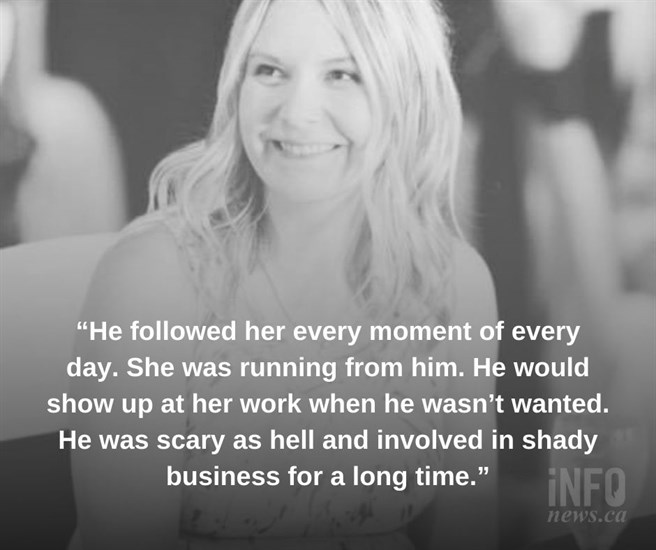
Image Credit: SUBMITTED
Instead, Sean Fouts was released in June 2020 and according to several sources, reintroduced himself to Katherine’s life at a time she was already stressed amid a heightened need for her work housing kids in a pandemic.
“He followed her every moment of every day,” an anonymous friend said. “She was running from him. He would show up at her work when he wasn’t wanted. He was scary as hell and involved in shady business for a long time. Sometimes we wouldn’t have contact with her for hours and we would all be worried.”
He showed up at her home as well and Bowden said he broke in once. Sources said even if not in the office, he was often seen driving by. And it put Katherine in an impossible situation. Her worlds were colliding. According to several friends, she chose to capitulate.
"On one hand she felt morally obligated to give him a chance,” Bowden said. "He helped her out and she wanted to return the favour and make a full circle. She was trying to heal herself in a way too, she wanted to give back to him and feel free of the burden that she owed him something. Because she felt like she owed him.”
“They had feelings for each other,” one friend said. “She wanted what was best for him and unfortunately he wasn’t what was best for her.”
She couldn’t have him hanging around A Way Home Kamloops, so she relented as a peacekeeping measure, Bowden said.
"She thought that she could rationalize with him, get him to back off, get him to clean up his own life,” he said. “She was looking for a way to placate him out of the scene.... She felt like he'd never hurt her.”
She was mistaken.
Whatever relationship they had before, it was different now. They were together often, but Katherine felt she couldn’t be seen with him in Kamloops. Instead they spent weekends away in Vernon, Penticton and Vancouver.
"He had his mind made up, she was his girl, she was always his girl,” Bowden said. "I mean there was just ongoing incidents of her getting beaten up, like straight up beaten up, dresses ruined, ripped right off of her, jackets destroyed... every second day there was incidents."
One friend said McParland once confided that he was violent when they were together in 2009. Bowden said he personally saw bruises on Katherine's body. iNFOnews.ca has seen text messages from McParland acknowledging that Fouts gave her a black eye. Others later witnessed bandages on her hand.
Katherine was known for the care she put into her appearance and often wore dresses, so sources say everyone noticed when she started wearing hoodies, sweaters and long sleeves, not long after Fouts entered the scene. They say she was terrified not only of him but that her staff, supporters and donors would find out what was going on.
Fouts was back dealing drugs, making plenty of cash, which made it even harder for her to escape.
"Now he’s got the money to pursue Katherine. That is where the means came in where she was like 'I can’t get away from this. He’s got power, he’s got money, he’s got influence.'”
Though she had spoken to him about boundaries, he continued to “love bomb” her, as another friend put it: Buying flowers and gifts and sending them to the office.
Meanwhile at the office, several staff members of A Way Home Kamloops, including youth ambassadors, were scared of him. Fouts has had several vehicles including a black pickup truck. One staffer later had a window shot with a BB gun and saw a black pickup truck driving away and presumed it was Fouts. A photo of him was taped up in the Safe Suites that A Way Home provided, warning people not to let him in the building.
Whether Fouts was responsible for any of these incidents or not, many people around Katherine were aware of him and they were scared of him, partially by reputation. Several people who knew Katherine would only speak anonymously out of fear of Fouts, others wouldn’t speak at all because they are afraid of him and others would speak about anything but Fouts.
***
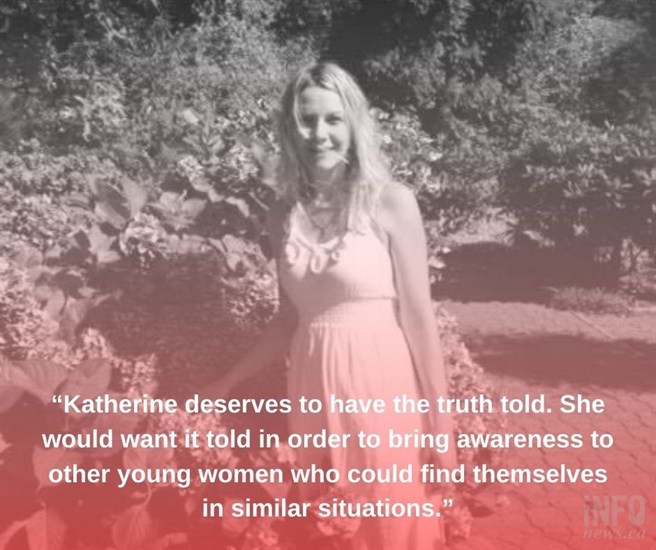
Image Credit: SUBMITTED
When Katherine flew to Victoria in November 2020, it was supposed to be an escape plan. Friends and supporters who knew of her situation implored her to get out of town. She had already relapsed, friends knew she was dealing with violence and they were afraid for her life.
Despite how Katherine explained her approach and strategy for dealing with Fouts to friends, it’s also true that she made choices to remain with him. And not all of her social circle were prepared to support that.
Katherine had distinct groups of friends, some who had never heard of each other. Friends forged by hardship in her earlier life stuck with her no matter what. But some of Katherine’s new professional friends began to cut off contact with her as a strategy.
One important friend and contact for Katherine told her in early November 2020 that she “has been trying to help you more than you have been trying to help yourself” and refused to do it any longer. The friend confronted her over her relapse and growing use of alcohol.
Katherine then committed to change and the Victoria plan was put in motion.
While there, Bowden said she explained everything about her past relationship with Fouts and her current issues. It was the sole focus of her attention but within a week, it appeared work pressures Katherine was facing had begun to mount.
She was a hands-on manager, sources say. She didn’t share duties or plans often and didn’t hand over the reins easily. She was worried about finishing payroll and had her signature awareness and fundraising event, the Campout to End Youth Homelessness, coming up in December. She had had great success in the past getting well-heeled members of the community to walk in the shoes of homelessness and they were due to return in mid-December. No one else knew how to do it and it wouldn’t be the same without Katherine McParland.
"She knew everybody (at A Way Home) was working paycheque-to-paycheque through COVID… she was adamant on going back,” Bowden said. "Everybody was like, no, don't go back. I basically told her you're putting your life in danger. Everything I told her came true.”
***
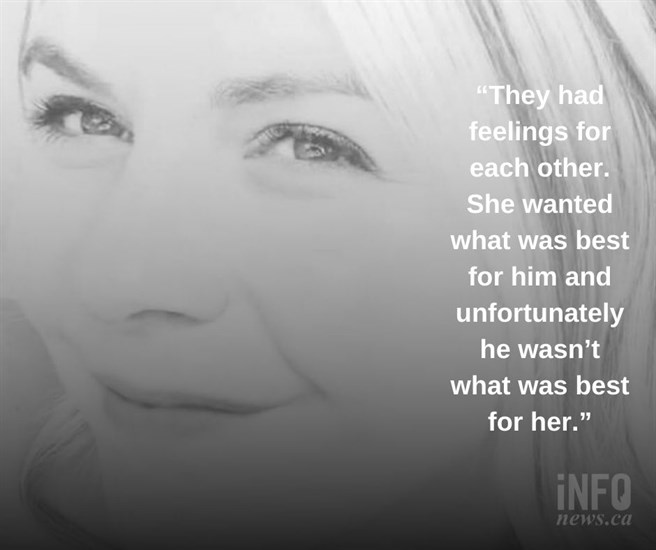
Image Credit: SUBMITTED
Bowden said they made plans for her return to Kamloops in the second week of November 2020. She said she was going to stay away from Fouts and she had several friends, including Bowden, willing to keep her accountable, stay in regular text and phone contact to ensure she was safe.
"As soon as she got back, he was there. The incidents started again. It was usually Friday night when it escalated. During the week, she could kind of get away from him because of her work. But on the weekends, she was forced to spend the full amount of time with him. Friday night was usually the peak. Saturday was the apology day. Sunday was I'll do anything for you day."
Bowden said one Friday night Katherine phoned him from the bathroom of a hotel room in Penticton or Vernon, while Fouts slept in the other room.
“She was like 'we’ve gone down the rabbit hole again, I’m scared, I can’t get away. It is his vehicle we’re in…,’” Bowden said.
He said Fouts woke up, grabbed the phone and threatened him. Then he, too, felt he had to pull away to protect his own family. He changed his phone number, deleted Katherine from Facebook and covered his digital trail in case Fouts wanted to make good. Katherine was to be more careful with her communications to him and pretend they weren’t communicating, but they kept the accountability checks.
"It was only phone calls for the last two weeks. She was doing accountability with two other women and maybe another one. They were doing the texting and I was doing the phone calls and I had times set up for her to call me with her work phone. It was basically so that she could tell him she wasn’t in contact with me.”
He’s since taken a different tack in allowing his name to be used for this story. He said he grew up in this lifestyle and refuses to be afraid. He wants his name public, thinking a higher profile will make it harder for Fouts or anyone else to come after him.
While he pulled back from his regular contact, he took a different approach, reasoning that all would be resolved if he could just remove Fouts from the situation. He said he started phoning the Kamloops RCMP drug squad, explained her situation and tried to give them enough information about Fouts’ drug activities to get him arrested.
He gleaned information from Katherine, including Fouts’ address, his vehicles, his major supplier and where he was selling. He had what he said was reliable information that Fouts was selling drugs in government-run motels and soaking up COVID-relief cheques. Bowden said he thinks Katherine knew what he was doing, though they never discussed it. He hid Katherine’s identity from police.
"I remember her getting mad and saying, 'I don’t want the police to even know my name, I don’t want my work involved.' Everything was very important to her about her work, like keep her work separate from her personal life,” he said. "But I think she knew. We were all… trying to find a solution. She knew the easiest solution was if he got caught selling drugs and was taken off the street that would be it, it would be over. He couldn’t come after her if she was in jail.”
It was the same reason she wouldn’t report any of the other violence, why she wouldn’t seek help.
She was just a few weeks before the campout event and still dealing with the complications of the pandemic and Bowden believes she was becoming more terrified by the day.
Bowden said she called him from work Monday, Nov. 30, 2020 after a terrible weekend. She said Fouts broke her finger, she had bruises on her arms — and she had overdosed on Friday.
She had relapsed at least a month before but not long before then.
She told Bowden she thought Fouts gave her a hot shot — too much drugs — and now believed he wanted to kill her.
Bowden thinks that was entirely possible if her plan was working. If she was doing what she said — removing herself from his life, and he saw the end coming, this was a foreseeable reaction.
He said she planned to avoid him all that week. Between Bowden's calls, something else was happening. On Wednesday, she sought out a therapist in Kamloops and swore she wouldn’t see Fouts again — she was going to break it off.
Bowden spoke to Katherine for the last time Friday, Dec. 4, 2020.
"She was being successful at (her plan to avoid him) and that’s when the surprise came. Because Friday she was like 'I’m going home, I’m not going to hang out with him and I’m not going over there.’”
He wasn’t the only person she told that to.
“Then she went off the radar. It was like 8 p.m. And everybody was phoning her, pinging her phone, maybe three of us and we didn’t know the other one was calling but three of us on our own accord called the RCMP and said we have a girl here who has gone missing… she is supposed to be doing accountability checks, she’s in a dangerous situation and we need you to find her.”
What happened next is a mystery to all but Sean Fouts and perhaps her closest friends.
She was found the next morning laying on her back on the floor in Fouts’ apartment. Coroner Elizabeth Evanski said “she was witnessed ingesting illicit substances the night prior” but didn't say who witnessed her. Evanski also said there was no “observable traumatic injury or evidence of foul play.”
Near her was burnt tin foil with residue and a “purple rock-like substance.” She died of an overdose of fentanyl and etizolam, a benzodiazapene that can hasten respiratory depression.
One month earlier, a drug alert was issued in the South Okanagan for a “dark pink and purple substance sold as down.”
Nine days after she died, another drug alert for Kamloops warned of a "purple chunky substance" being sold as heroin, containing benzodiazepines and fentanyl.
Another on January 8, 2021 also described “purple granules”.
In December 2020, 163 people in B.C. died of an overdose.
Sixty people from Kamloops alone died of overdose in 2020.
More than 11,000 people in B.C. have died of an overdose since 2012.
If you or someone you know has a drug problem, you can get help.
Call HealthLink B.C. at 1-800-663-1441 or go to this website.
***
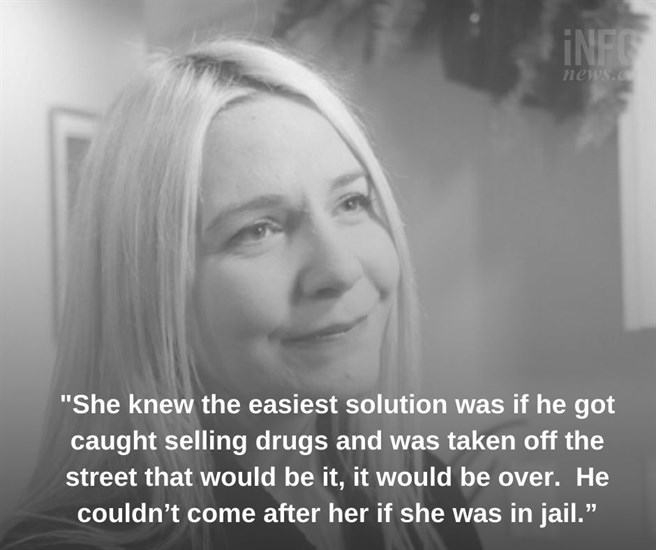
Image Credit: SUBMITTED
Bowden was one of the first to know. He got the call from his contact at the RCMP that morning saying they identified her body.
He was angry and sad at the same time. He makes it very clear — he believes Fouts killed her because she was ending it, and so do several other friends.
The last he heard from her was a message he said he got on his phone the night she died.
“I can’t remember what happened but she called my phone and I hadn’t been able to answer it and she left a message that (Fouts’ drug supplier) had been waiting out front of his place which was really confusing. She said (the guy) was waiting in the lobby with me… and he said he knows that I’m doing something and the thing that scared her the most was… after this conversation with her, he left and he went to a flower place ... and he had a bouquet of flowers sent to her with a note that said something like ‘farewell' or 'enjoy the trip' or whatever, a couple hours before she overdosed."
“I played that tape over probably fifty times in the next couple of months, I even played it to the police over the phone…. She was like, 'I don’t want to be here, I’m supposed to be at home.' She was panicking on the phone and it was all over the map and I did think she was using because she was just so scattered all over the path. It sounded really manic and desperate.”
He said the RCMP knows everything he knows but he doesn’t know how much they investigated her death beyond the overdose. He also saw and heard no evidence police ever investigated or acted on his tips about Fouts’ drug activity. Bowden said he kept the voice messages, call logs and text messages for roughly a year, but lost them when he got a new phone. He had no intention of sharing the story until he was contacted by iNFOnews.ca.
All our sources had hoped the coroner’s investigation would yield more information, but the coroner was only investigating the cause of death, which clearly was an overdose. But it’s also true that once Fouts re-entered her life, she sacrificed her mental and physical health, put her work and future in jeopardy, relapsed, overdosed and died — all within six months.
It wasn’t as simple as the coroner’s report left it.
“There were times she would be talking to me on the phone and she would be whispering: 'I know he’s outside, I know he knows I’m in here,'" one source said. "She was living in terror. And yet she was also afraid of the repercussions of breaking it off. And that’s the bottom line and that’s the truth for many women who are stuck in these kinds of situations.”
“(The coroner's report was) just… upsetting… because of the lack of context. It just left her out there as an OD and there is clearly a lot more to this,” another friend said. “I think our hope is that if anything ever comes out of this, it can be a warning to other young women.”
“Katherine deserves to have the truth told. She would want it told in order to bring awareness to other young women who could find themselves in similar situations.”
It doesn’t sit well with Bowden either to have such a simple explanation of how she died when he knows there’s more.
"She had so many injuries on her body (I hoped) that maybe they would take it a little bit further… but it is so hard to prove that she didn’t do it on her own.
"It didn’t matter if you had all this information, it didn’t matter that you were telling the cops, she is telling everybody that he is going to kill her and then she’s dead, what do you think? And they’re like, you can’t prove it. We have nothing to prove it."
iNFOnews.ca tried to speak to police about investigations into Fouts’ drug dealings and McParland’s death, as well as an off the record conversation about the safety of sources in this story but Kamloops RCMP refused to speak about this case in any meaningful capacity, releasing only this statement.
“Due to privacy laws, which remain in place even after an individual is deceased, I cannot go into specific details regarding police involvement or interactions pertaining to Ms. McParland. I can confirm that police were called to the 100-block of Lorne Street around 9:13 a.m. to assist EHS with a person in medical distress on Dec. 5, 2020,” spokesperson Const. Crystal Evelyn said. “The person was declared deceased at the scene. Police investigated and contacted the coroner to conduct a concurrent investigation, as per the Coroners Act.”
***
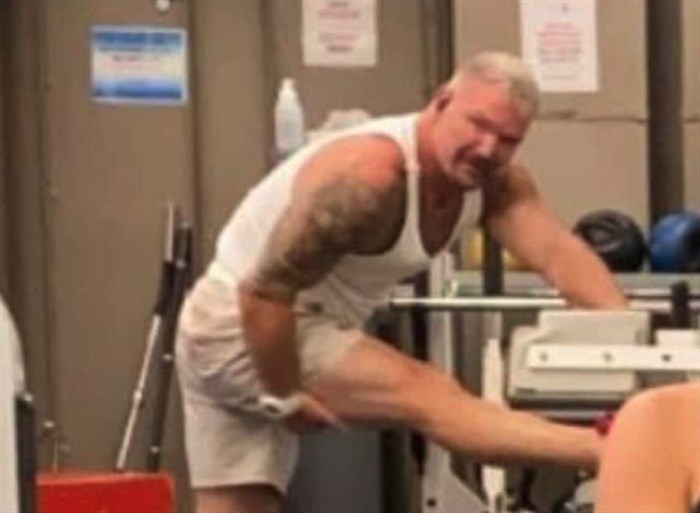
Sean Fouts working out at a Kamloops gym.
Image Credit: Contributed
A friend of Sean Fouts gave us his phone number and he was eager to speak.
“I would have never harmed her, absolutely not,” he said. “I loved her, at least I think I did. I definitely cared for her a lot.”
He said many things about Katherine, including allegations iNFOnews.ca refuses to repeat without verification where none was found. He denies every allegation.
He said he and Katherine shared a connection from their earlier days together. He described Katherine as leading two lives, the one she told her friends about and the one with him she had to hide.
“Here's the thing, because I'm not seen as a prize, I guess, in the community of Kamloops because of my history and she had done her work so well and was respected and things she did... it was kind of more of a hidden relationship to some degree I guess,” he said.
He admitted his own drug use in the last half of 2020 and said because of that drug use, he couldn’t remember several incidents or specifics, at least until prompted on occasion. Many of his answers to questions are based on what he’s heard from others. He said one of Katherine’s best friends told him after she died that Katherine was telling other people she was scared of him and that he wouldn’t leave her alone. He said he was unaware of her allegations until then.
He said he has no recollection of Katherine overdosing Nov. 28 but said he was told by someone that he took her to the hospital that day. He denies the notion that he gave her a lethal overdose and said common sense would dictate he wouldn’t have driven her to hospital if that were true.
He denied that Katherine ever used his drugs.
He initially denied knowing the named drug supplier, until he was confronted with specifics. He said he has no knowledge of the supplier giving Katherine flowers and can’t conceive of why he would have done that if it were true.
He said he has moved away from Kamloops but yet can still be seen regularly driving around the city in one of his three vehicles or working out at a local gym.
Despite a police news release and a mention in his Parole Board of Canada report, he said he is not and never has been in the Independent Soldiers gang.
Despite his record and mention in his parole board reports of domestic violence, he denies ever being violent towards intimate partners. He denied ever being violent with McParland and specifically the injury to her hand.
"Absolutely not true at all,” he said. “What happened was, during a fight I chucked a phone towards her kind of, in the fight, and it hit the top of her hand… and I don't know if it was bruised but I'm sure it hurt. I remember afterwards rubbing it and kissing it trying to make it feel better because I felt bad that I did this. I remember doing all that stuff…. At no time did I ever put hands on her or anything like that. I am not a violent person towards women, I never have been.”
He denied stalking her.
"I wouldn't say I was hanging around (A Way Home Kamloops). I went there the first time. I had gone there a few times, I was going to pick her up because I think her car was in the shop and she's like 'listen you can't come around here.' I remember her saying that, I remember I went again after she died and I was a mess and crying... and that was the only time I was ever around that place anytime. You drive by…. it's a small town, right? But I… was never hanging around that place. She didn't want me to come around there so I absolutely respected that but to say that I was never around there that wouldn't be true either. I had gone around there a few times.”
He also said he wasn't with Katherine the night she died. He said he was using that night and passed out and when he woke up, she was there beside him. He said again she didn't use his drugs. He said Katherine’s best friend told him later that Katherine was out that night trying to buy her own.
"I was unconscious... there's a lot of benzos in that stuff and I obviously was knocked out from it and it affects your memory and so forth, right? (Katherine’s best friend) called me like a week later and wanted me to know the truth, I think she realized that I was blaming myself and did me a huge favour by giving me the actual facts otherwise… I probably wouldn't be here because I was blaming myself initially.”
It doesn’t make much sense that Katherine would be seeking drugs elsewhere considering Fouts had more than she needed but he claims evidence exists that proves his claim.
iNFOnews.ca tried to access these text messages, but some of Katherine’s closest friends and family declined to participate in this story, saying Katherine would have wanted privacy and wouldn’t want this story to be written.
Fouts wants you to know he’s clean. He sounded clear, focussed and rational on the phone.
"I have been working on myself and making myself better and I've paid for my mistakes so it'd be nice for people to.. allow a guy a chance to correct his life and make up for the mistakes that he's made,” he said. "The death of Katherine has assisted me in making better choices in getting my life together and getting clean so if nothing else I would like that to be said. That something good did come out of this. Even though it's a horrible situation, it allowed me to really focus on myself and get my shit together.”
***
If you are experiencing intimate partner violence, seek help.
Dial 911 if you are in immediate danger.
To talk to someone about a plan to protect yourself or your children, call 1-800-563-0808 or go here.
Know the warning signs.
***
Katherine's work continues.
Last September, A Way Home Kamloops announced it would build Katherine's Place, a 39-unit complex for homeless youth and young adults in Kamloops.
This year, 80 youth in Kamloops are waiting for help from A Way Home Kamloops to get into either market or supported housing.
The organization currently supports 73 youth with various housing arrangements.
If you can help, get in touch with A Way Home Kamloops here.
To contact a reporter for this story, email Marshall Jones or call 250-718-2724 or email the editor. You can also submit photos, videos or news tips to the newsroom and be entered to win a monthly prize draw.
We welcome your comments and opinions on our stories but play nice. We won't censor or delete comments unless they contain off-topic statements or links, unnecessary vulgarity, false facts, spam or obviously fake profiles. If you have any concerns about what you see in comments, email the editor in the link above.
News from © iNFOnews, 2022